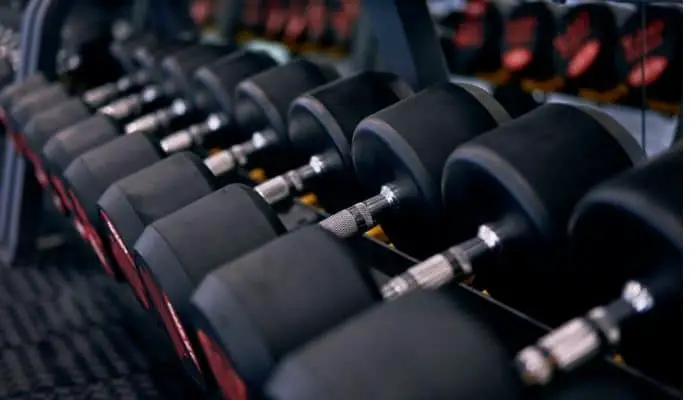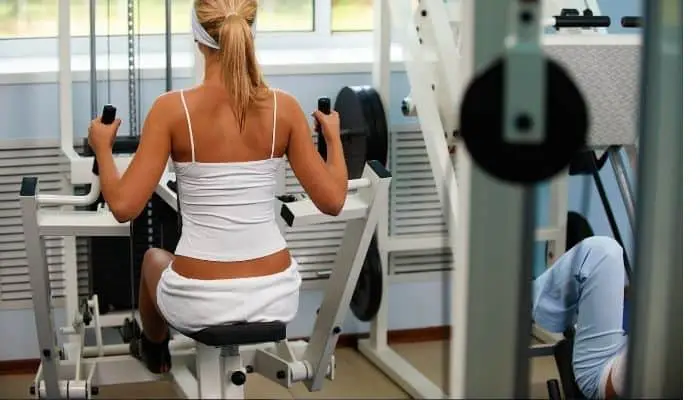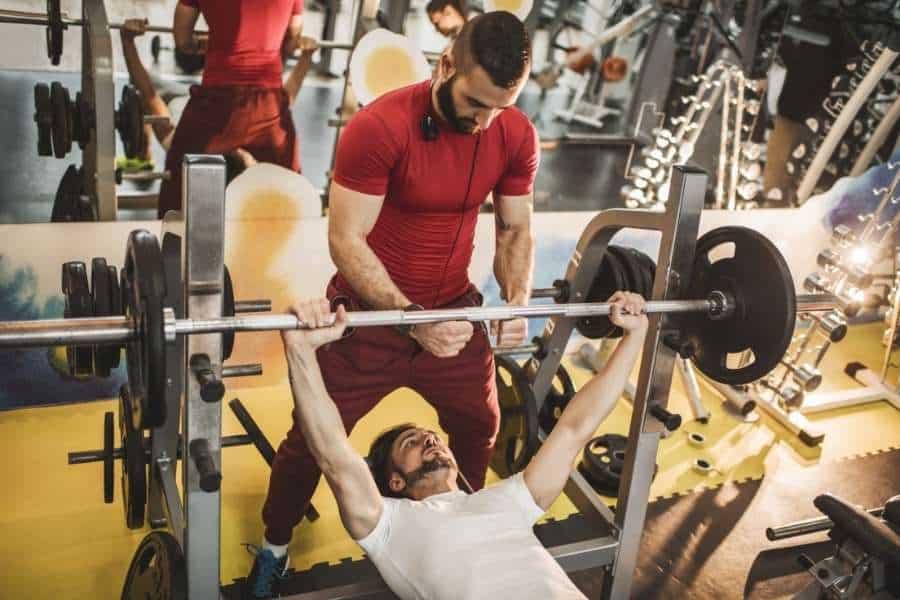Weightlifting is often done with a partner or spotter who can help you out when you fail your repetition. However, in a home gym or a quiet commercial gym, this isn’t always available. So what can you do to keep training safe without a spotter?
The best way to stay safe while weightlifting alone is to use a power cage with properly set up safety pins. Changing to dumbbells, using barbell clips, not training to failure, and avoiding ego lifting are also important ways to reduce risk.
Let’s get into the best things you can do to stay safe when weightlifting without a spotter.
Contents
- 1 8 Tips To Train Safely Without a Spotter
- 2 1. Use a Power Rack
- 3 2. Set Up The Spotter Arms
- 4 3. Change To Dumbbells
- 5 4. Multi-Gyms/Machines
- 6 5. Don’t Forget The Barbell collars
- 7 Training and Programming Choices
- 8 6. Don’t Train To Failure
- 9 7. Pay Attention To Form
- 10 8. No ‘Ego’ Lifting
- 11 When Do You Need a Spotter?
- 12 Can You Make Training Solo In a Home Gym 100% Safe?
8 Tips To Train Safely Without a Spotter
Of course, you could train with a buddy in a home gym as long as there’s enough space. But one of the benefits of having a home gym is that you can work out in peace, alone. And some home gyms are just too small to work out in with two people. You still want to be safe though. So what options do you have to stay safe while working out hard?
There are two approaches you can take to make training in a home gym safe without a spotter;
- A: Equipment choices
- B: Training and programming choices
1. Use a Power Rack

The first thing to make your home gym safe that should be on the top of everyone’s list is a power rack. A power rack can provide quite a bit of safety for a lot of exercises.
A power rack or cage has four upright posts that are braced at the top and bottom. The upright posts have many holes in them. Those holes can be used to place things called ‘safety pins’. Those are basically metal bars (or sometimes nylon straps) that are meant to stop the barbell from going down below a certain point. That’s exactly what you need.
The holes in the upright posts mean you can set up the safety pins at any height you want/need. That height is usually the highest you can set it without it interfering with the exercise. In other words, you see the safety pins just a little below the lowest the barbell comes during a certain lift. If you don’t know exactly how high that is, try the exercise with an empty barbell first and see how low you can go.
Every exercise is different so to keep yourself as safe as possible, it’s good to set a different safety pin height for every different exercise.
2. Set Up The Spotter Arms
If you have a squat rack, squat stands, or want to lift in front of the power rack, some spotter arms do the same job as the safety pins in a power rack. Spotter arms are metal bars that stick out from the front of a power or squat rack. So instead of being mounted between two upright posts, spotter arms are only attached on one side and stick out.
That means they can handle a bit less weight than spotter arms because if you put a very heavy load on these, the whole rack might topple over.
3. Change To Dumbbells

Substituting barbell exercises with dumbbell exercises can improve safety. It’s much easier to let dumbbells fall to the side without hitting yourself. Many exercises you can do with a barbell can be replaced with a dumbbell exercise
Dumbbells can be bought in very heavy versions so in that regard you don’t have to give anything up. However, heavy dumbbells are quite expensive and it’s not as easy to increase the weight in small increments slowly over time. So if you need a lot of heavy dumbbells, it will take up a lot more space and cost way more than a barbell and set of weight plates.
Also, with barbells, you can generally lift more weight which can result in more muscle and strength gains.
So using dumbbells is a bit of a trade-off. More safety but more expensive and takes up more space. That only applies to really heavy lifts, however. For exercises where you use 60 lbs. dumbbells max., the trade-offs are not that big.
4. Multi-Gyms/Machines

Of course, you can choose to get rid of free weights completely and work out with machines. With machines, there is nothing that can fall on you and the movement patterns are set so there are very few ways you could hurt yourself although it’s not impossible.
Machines do have a few drawbacks though. They take up a lot of space. To get a full-body workout you need a lot of different machines and that setup would be bigger than most home gyms. It’s also very expensive compared to a free weights setup. And you leave a bit of muscle and strength gain on the table by using machines.
One way to get around two of the three downsides is to use a multi-gym. A multi-gym is a single machine that can be used to work out all the muscle groups in your body. They take up about the same amount of space as a free weights setup. They can cost the same or a bit more and are safer than free weights.
5. Don’t Forget The Barbell collars

Barbell collars are a safety measure if used properly. Barbell collars fix weight plates on the barbell by clamping down around the barbell sleeve.
Plates sliding off one side of the bar means that that side suddenly becomes very light and the other side pulls down and whips the bar around. Since plates often try to slide off in a situation where you’re already unbalanced, that will make it much worse and the chance you hurt yourself goes up a lot. If you try to hold on to the bar, the moving weight will twist your body in ways that aren’t good. Not to mention the falling weight plates that can hit your feet or mirrors.
Training and Programming Choices
The right equipment can be a great safety measure for when things go wrong. However, preventing dangerous things from happening is always better than just counting on the equipment to save you. I mean, would you rather wear body armor or not get shot? Of course, avoiding getting shot is the best thing.
Working out is kind of similar but instead of getting shot, the weight can hurt you. Of course, you can’t always avoid accidents from happening which is why you want to combine both the equipment and workout safety strategies.
But let’s get into what you can change in your training to keep you safe in a home gym.
6. Don’t Train To Failure

The biggest reason to need a spotter is because you fail a repetition. The biggest way to not need a spotter is to not train to failure. Just leave one or two reps in the tank so you always know you can re-rack the bar.
Beginners can have a harder time guessing how many reps they have left. If you’re not certain of yourself, you can see if you can find a spotter for a few sessions to get your expectations dialed in.
Training to failure does have its place in training but for big, multi-joint exercises it’s not a good idea to go to failure anyways since the risk of hurting yourself is not worth the possible benefits. Recovery will also take longer which means your next workout might be affected.
On some exercises, you can still go to failure without many issues. However, squats and bench presses for example are quite dangerous to fail on since you can easily get pinned on the barbell. Changing to dumbbells is an option if you want to go to failure on those exercises.
On the squat, you can set up the spotter arms to the correct height to a little below your lowest point and then you can just push the bar off your back if necessary. On the bench press, you can set the spotter arms just below your chest where the bar touches. Then, if you fail, you will feel some pressure on the chest but you can roll down the bar to your belly at which point the spotter arms will take over. That only works if you have a relatively small belly though.
You could set up the spotter arms at chest height or a little higher but this will limit the range of motion which is not ideal either.
7. Pay Attention To Form
Lifting heavy with bad form can hurt you even without needing a spotter. There are a few ways how good form makes lifting safer.
Lifting with good form means your body moves in the way it’s meant to. Some ways of moving just have such a big impact on your body that it’ll start hurting sooner or later. Good form is the form where you can keep doing that movement for a long time without injury.
Keeping good form usually means you have to use a lighter weight. A lighter weight means you’re less likely to fail a repetition and if you do fail, the forces on your body will be lower which means a lower injury risk. Combined with some equipment that can catch the bar in case things go wrong, the risk of injury is so much lower.
8. No ‘Ego’ Lifting
This ties in with the last point but it’s worth highlighting from another angle. ‘Ego’ lifting is if you lift too much weight so you can’t perform the lift with good form just to show off.
In a home gym there is nobody to show off for anyway so don’t let the numbers get to your head. Follow a program and don’t start lifting weights you can’t with good form because that’s when form breaks down and bad things happen.
When Do You Need a Spotter?
To see how we can replace a spotter and make solo training safer, first let’s look at when, where, and why you need a spotter.
A spotter’s first responsibility is to prevent the lifter from getting hurt. Another reason people use spotters is to help you get the last repetition while you would fail otherwise. However, keeping the lifter safe is by far the most important job of a spotter.
A spotter has to (help) catch the weight in case something goes wrong. Usually, this is when you fail a repetition and can’t re-rack the weight or even collapse under the weight. The lifter could also lose balance which is hard to recover from by yourself but a spotter could help you safely rack the weight.
There are a few types of exercises where it’s wise to use a spotter;
- Barbell exercises where it’s easy to get pinned under the bar (Bench press, squat)
- Dumbbell exercises where a failure could hurt you. (Dumbell press, Shoulder press)

If you lift more than you can handle on a squat, for example, the body part that’s likely to fail is your legs or maybe back. When that happens and you can’t keep the bar up and get it back on the pins, there’s only one way for the barbell to go and that’s down. The problem is that you are between the barbell and the floor. That way, you can get pinned under the bar. That can be very dangerous and cause injuries.
So for barbell exercises where you are between the bar and the floor, having a spotter is very useful.
On some heavy dumbbell exercises having a spotter is useful too. While dumbbells are usually very easy to throw to the side and not hit yourself. However, on some exercises like skull crushers (where do you think the name came from), dumbbell presses, and shoulder presses, a spotter is still useful. With those exercises, the dumbbell could hit your head in some situations. Dropping a 30 lbs. weight in your face is not the most comfortable thing in the world.
Can You Make Training Solo In a Home Gym 100% Safe?
Any time you move, you run the risk of hurting yourself. Add in heavy weights and the chances you get hurt increase significantly. Of course, we take risks every day. Some risks are worth it to us because we think the rewards are worth it or necessary.
Weightlifting in any gym and with any spotter has its risks but, we take those risks so we can improve our physique and health. And in a commercial gym with a spotter, there still are some risks to weightlifting. So weightlifting is never 100% safe because nothing really is.
So the real question is if we can make weightlifting at home just as safe as with a spotter? I’ve been training without a spotter for years now without problems (at least not problems that could have been prevented by a spotter. Of course, when you are alone, you have to keep in mind that there’s nobody that can help you when you get in trouble.
However, by taking all/some of the precautions above, you can reduce the risk of you getting hurt dramatically. I would say that if you take all the precautions above, your risk of getting hurt is quite similar to what it would be with a spotter. That’s because by taking the safety precautions and keeping in mind you’re alone, you’re a lot less likely to do stupid things and push too hard.
And if you think that taking safety so seriously is a bit too much, think about this; If you get hurt, you can’t train at all but taking the safety measures doesn’t impede your training at all. So besides some thought and maybe an extra piece of equipment, there is no downside to being safe.
Don’t forget to check out the exact floor plans and equipment that make your home gym perfect! Get it here.

